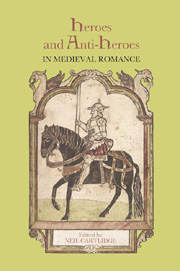12 - Saracens
from Part II - Character-Types
Published online by Cambridge University Press: 05 February 2013
Summary
Although scholars often disagree about what defines a medieval romance, most agree that romances share a concern with heroic exemplarity, be it chivalric, religious, or moral. Yin Liu, for example, writes:
these texts are about exemplarity. The protagonist […] is unfailingly described as the best knight of the world, or the most beautiful woman; the knight's personal armor is always the best ever made, his horse the strongest, his battles the most spectacular; the protagonist's hardships are inevitably the worst ever suffered.
This emphasis on exemplarity, however, may blind readers to the complexity of the characterization of some romance protagonists and their antagonists. Sometimes the heroes of medieval romance are not nearly as admirable as the textual celebration of their victories implies, and sometimes the hero's enemies are not nearly as vile as their discomfiture implies. Indeed, the antagonists in many romances are depicted in ways that call into question the exemplarity of the heroes who fight them. This essay explores the extent to which Saracen knights in Middle English romances cast a critical light on the Christian heroes they encounter, and what such criticism might imply about the nature of the heroic behaviour depicted. Admittedly, many of the Saracen warriors who appear in romance do serve simply as occasions for the demonstration of Christian martial prowess. However, some play much more substantive narrative roles. These Saracens tend to fall into two broad categories: those who convert to Christianity and those who refuse to do so.
- Type
- Chapter
- Information
- Heroes and Anti-Heroes in Medieval Romance , pp. 185 - 200Publisher: Boydell & BrewerPrint publication year: 2012

